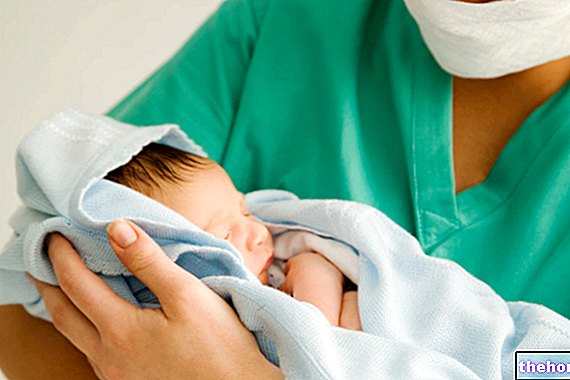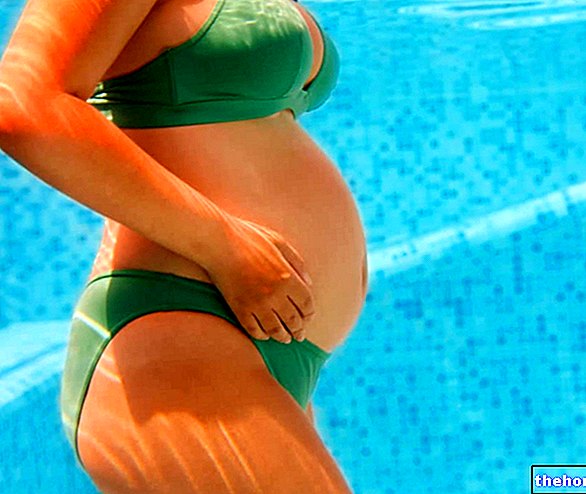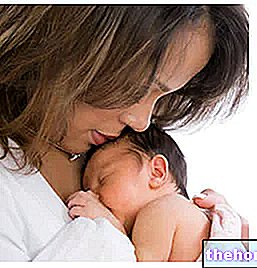See also: placental barrier
The placenta is a deciduous organ, therefore temporary, which forms in the uterus during pregnancy. The placenta is responsible for nourishing, protecting and supporting fetal growth.
The placenta is common to the pregnant woman and the fetus; a part of it, in fact, has maternal origins (constituted by the modified or deciduous uterine endometrium), while the remainder has fetal origins (formed by the chorionic villi) .The placenta, therefore, represents the roots of the fetus in the mother's soil.
The chorionic villi are highly vascularized extensions generated by the outermost layer of embryonic cells (the chorion), which branches out and sinks into the uterine mucosa (endometrium).
The endometrium of the uterus transformed for pregnancy is called decidua and is made up of decidual cells, very large and rich in glycogen and lipids.
Process of formation and development of the placenta

Around the seventh day begins the implantation (or nesting) of the blastocyst in the endometrium, thanks to the release of particular proteolytic enzymes by the blastocyst itself. This, after having penetrated it, is completely enveloped by the endometrium (twelfth day) and continues its development. The embryonic cells that will become placenta begin to form digitiform offshoots, called chorionic villi, which penetrate into the maternal vascularized endometrium releasing enzymes that corrode the blood vessel walls. From this moment on, numerous villi will undergo further ramifications and structural transformations, sinking even further into the uterine mucosa, to originate an intimate system of exchanges which, under the name of placenta, unites the mother to the fetus [at first the villi are distributed on the entire surface of the chorion but, as pregnancy proceeds (around the third month), only those adjacent to the basal decidua develop - forming the leafy chorion - while those facing the capsular decidua degenerate (smooth chorion)].
At the end of their differentiation, the chorionic villi are internally vascularized and immersed in blood gaps filled with maternal blood. Despite this, the embryonic and mother's blood do not mix, and most of the substances are exchanged through the thin walls of the chorionic villi (placental barrier).
At the final stage of maturation, the placenta consists of a fetal portion, deriving from the leafy chorion, and a maternal portion, deriving from the basal decidua.
After the third month, the placenta continues to grow, until it reaches 20-30 cm in diameter, 3-4 cm thick (greater in the center) and 500-600 grams in weight shortly before birth; as a whole, it will occupy 25-30% of the inner surface of the uterine cavity.
The placenta, as we said, is richly vascularized and receives up to 10% of the total maternal cardiac output (about 30 liters / hour).
Functions of the placenta
The primary function of the placenta is to allow metabolic and gaseous exchanges between fetal and maternal blood. The fetus and placenta communicate via the umbilical cord or funiculus, while the mother communicates directly with the placenta through gaps filled with blood (blood gaps), from which the chorionic villi "draw".
Umbilical vessels include an umbilical vein - which carries oxygenated, nutrient-rich blood from the placenta to the fetus - and the umbilical arteries, which contain catabolite-rich blood from the fetus to the placenta.
The functions of this body are very numerous, since it acts as:
- lung: supplies oxygen to the fetus and removes carbon dioxide; these gases diffuse easily through the thin layer of cells that separates the chorionic villi from the maternal blood.
- Kidney: cleanses and regulates the body fluids of the fetus.
- Digestive system: procures and supplies nutrients; the placenta is permeable to many nutrients present in the mother's blood, such as glucose, triglycerides, proteins, water and some vitamins and minerals.
- Immune system: allows the passage of antibodies due to endocytosis but prevents that of many pathogens (with the exception, for example, rubella viruses and toxoplasmosis protozoa).
- Protective barrier: the placenta prevents the passage of many harmful substances, although some can still cross it and harm the fetus (caffeine, cocaine, alcohol, some drugs, nicotine and other carcinogens present in cigarette smoke ...).
The placenta also has a very important endocrine function. From the early stages of its development, in fact, it secretes human chorionic gonadotropin (hCG), a hormone similar to LH that supports the production of progesterone by the corpus luteum (not surprisingly, therefore, the measurement of Human Chorionic Gonadotropin in blood or urine is used in pregnancy tests). From the seventh week onwards, the placenta reaches a degree of development sufficient to produce all the necessary progesterone on its own; as a result, the corpus luteum degenerates and, along with it, the amount of hCG produced by the placenta.
Human Chorionic Gonadotropin is important for stimulating testosterone synthesis in the developing testes of the male fetus.
In addition to hCG, the placenta secretes other hormones, such as human placental lactogen, estrogen (which inhibits the maturation of other follicles), progesterone (which prevents uterine contractions and supports the endometrium) and others (including inhibin , prolactin and pronenin). It is interesting to note that the placenta lacks some of the enzymes necessary to complete the synthesis of steroid hormones; however, these enzymes are present in the fetus. Thus, at least from the endocrine point of view, a relationship of "symbiosis" is established, so much so that we speak of "fetal-placental unit".
The placenta, therefore, provides for all the needs of the fetus, nourishing it, protecting it and building an intimate bond with the mother; a bond made of care and refusal, of dependence and autonomy which, in many respects, will accompany the two individuals also in extrauterine life.

-cos-come-si-calcola-a-cosa-serve.jpg)














.jpg)











